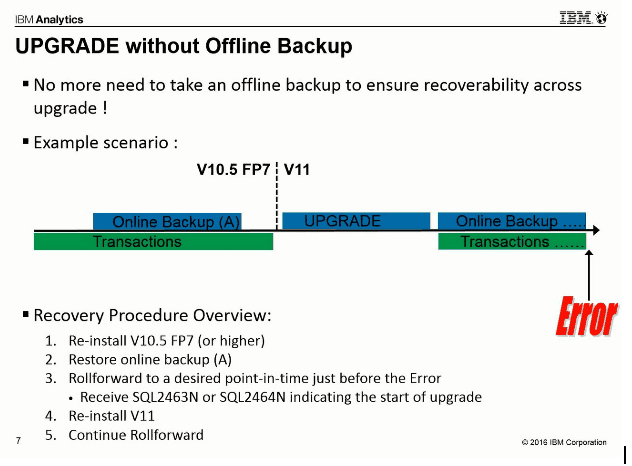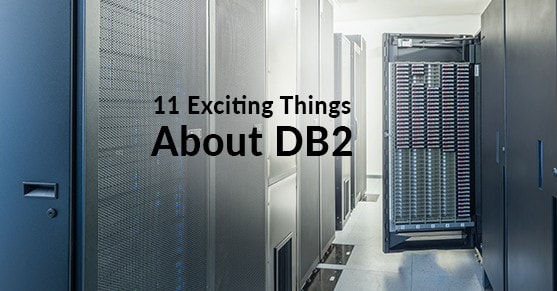Today is the day! On June 15, 2016, a new version of Db2 is being released! IBM has also announced that Db2 9.7 AND Db2 10.1 will reach “End of Support” on September 30, 2017. There is so much information flying out there, so I thought I’d share some details and resources.
End of Support for 9.7 and 10.1
What End of Support Means
End of Support(EOS) for any Db2 LUW product means that if you call IBM on a product that is past the EOS date, IBM will not help you. This is true, even if you’re paying your ongoing software support. There are no ongoing security patches or bug fixes after EOS. There are extended support contracts available for a short period of time after the EOS dates, to help companies who truly are stuck, but that only covers issues for user error and really sticky bugs discovered. A few IBM products will include support for an outdated version of Db2 after the EOS date, however this support is very difficult to get and not of the same class you might be used to from IBM support. It boils down to this: If you call IBM about a Db2 LUW product that is past the stated EOS date, IBM will basically refuse to help you. Or offer services at significant cost.
End of Support Dates
All IBM Db2 end of support dates are kept updated in this document: http://www-01.ibm.com/support/docview.wss?uid=swg21168270 There you can see the end of support date of September 30, 2017 for 9.7 and 10.1. You can also see the end of extended support dates past which you will not be able to pay dearly for support needed.
The Eleven Most Interesting Things About Db2 11.1 so Far
I love the excitement of a new version – finding out what it does and doesn’t do, and all the details around it. I’m excited about Db2 11.1, but won’t be recommending it to any clients until at least fix pack 2 or 3. Why? I don’t consider 10.5 fully stable until fix pack 5 because there were major bugs that affect the stability of the Db2 instance or HADR on both fix packs 3 and 4. At least one of these bugs I saw across multiple clients on multiple OS platforms. It’s still important to know the advantages and features of a new version so I can recommend it once it seems stable. I’ve already mentioned it to one client who is working on upgrade planning for mid next year – it might be ready by then.
#1: Direct upgrade from 9.7
Normally, you can only go up two full versions of Db2, with the full versions being:
- 8.2
- 9.1
- 9.5
- 9.7
- 10.1
- 10.5
- 11.1
With 11.1, IBM is supporting direct upgrade from Db2 9.7 to Db2 11.1 – a three version jump. This makes it much easier for some companies to upgrade directly to the latest version.
#2: Rollforward Through Upgrade
Before every upgrade, we take an offline backup. One of the big reasons for this is that a database at a later version cannot roll forward through transaction log files from an earlier version, and any restore of an online backup requires at least a little rollforward. Starting with 10.5, fix pack 7 or higher, you can now roll forward through transaction logs from before the upgrade. This means drastically reduced outage times for many upgrades! Matt Huras’ slide from the Db2 Night Show illustrates this perfectly:

To make use of this, you must start with 10.5 FP7 or above, and this doesn’t work on DPF environments.
#3: HADR Standby Doesn’t Have to be Restored After Upgrade
Starting with 10.5 FP7 or above, we no longer have to re-initialize the HADR standby by restoring a new backup to it after upgrade. Due to the ability to rollforward through backup, you can now place your standby in an upgrade pending state, then upgrade the code, and then let it rollforward through the upgrade.
#4: OLTP Performance Improvement Out of the Box
Due to improvements in bufferpool latching, high volume OLTP environments may see a performance improvement out of the box with no need for parameter changes.
#5: Several Little Things
They are not as big but there is a new option on the db2relocatedb command to generate a script – this is a huge bonus for those of us who have actually tried to use this feature. The introduction of some functions for regular expressions is also exciting, especially for Perl addicts like me.
#6: BLU: More can Happen Below the BLU Line
If you have done much with explain plans on BLU, you know that one of the goals is to make sure the “BLU line” – the columnar table queue that represents where Db2 gives up on the columnar engine for the row-based engine – is as high in the explain plan as possible. In Db2 11.1, several changes make it so more sorts and other operations can happen below the BLU line, which is a good thing for performance.
#7: Inline Optimization Hints (Is this a good thing?)
I question whether this is actually a good thing, but optimization hints specified inline with the SQL are now possible. The Db2 optimizer is a powerful tool, and I’m not a fan of circumventing it except in the most extreme circumstances. I suppose that this makes Db2 more like some other mainstream RDBMS platforms.
#8: BLU on DPF
While you can put 15-20 TB of uncompressed data on a single-partition BLU environment, there are some other, larger environments that need the ability to partition the data across multiple servers. Db2 11.1 will allow BLU with the Database Partitioning Feature – where one database is spread across multiple logical or physical nodes.
#9: BLU: Generated Columns, RCAC, OLAP, and Perf Enhancements
Even with individual fix packs, IBM has been making drastic performance improvements with BLU. This version is no different with not only performance improvements, but functionality ones as well. Some OLAP functions are now supported with BLU along with generated columns (a big improvement for ease of conversion) and the use of fine-grained access control (FGAC/RCAC).
#10: New Db2 Direct Packaging
This feature is fun because it makes it even easier to use Db2 in a virtual or cloud environment. Db2 already runs well and easily on virtual servers, but now the licensing is even easier. Licenses are by VPC (Virtual Processor Core) – and do not change based on the power of the core in question. This makes it easier for a Db2 server to move wherever a virtualization engineer thinks it makes the most sense without worrying about violating licensing agreements. Payments are monthly.
#11: Easier PureScale
PureScale has always been a bit difficult from the DBA’s perspective as it requires skill sets outside of those typical of DBAs – such as GPFS. In Db2 11.1, this gets easier with a simplified setup using the db2cluster command and drastically fewer steps.
Bonus: IBM Products Certifying with Db2 11.1
This may be my favorite one of all. John Lind, IBM’s Product Manager for Db2 stated in open session at the IDUG North American Technical Conference in Austin that every IBM application that certifies with Db2 11.1 and includes Db2 11.1 will have to include an advanced edition. This is great news, as some of the features in advanced editions, such as compression or extended features of DSM are very useful.
Summary
This is not comprehensive coverage of the Db2 11 changes. There are more things like enterprise key management and more. See the resources below for details on Db2 11.1. Db2 11.1 will be available on June 15, 2016.
Resources for Information about Db2 11.1
Official Announcement
Dave Beulke’s Blog
http://davebeulke.com/db2-luw-version-11-5-great-new-features-many-come/ http://davebeulke.com/db2-luw-version-11-5-blu-performance-improvements-applications/
Db2 Night Show
http://www.dbisoftware.com/blog/db2nightshow.php?id=680 http://www.dbisoftware.com/blog/db2nightshow.php?id=682 http://www.dbisoftware.com/blog/db2nightshow.php?id=688

